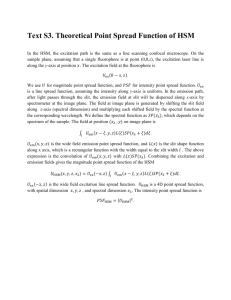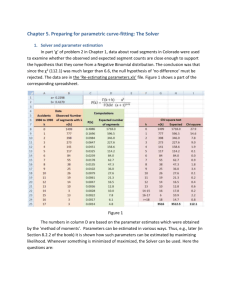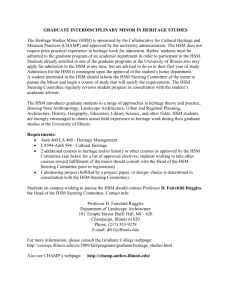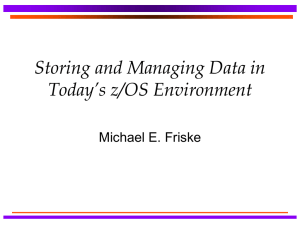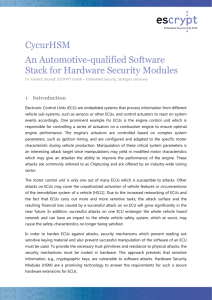here - evita
advertisement
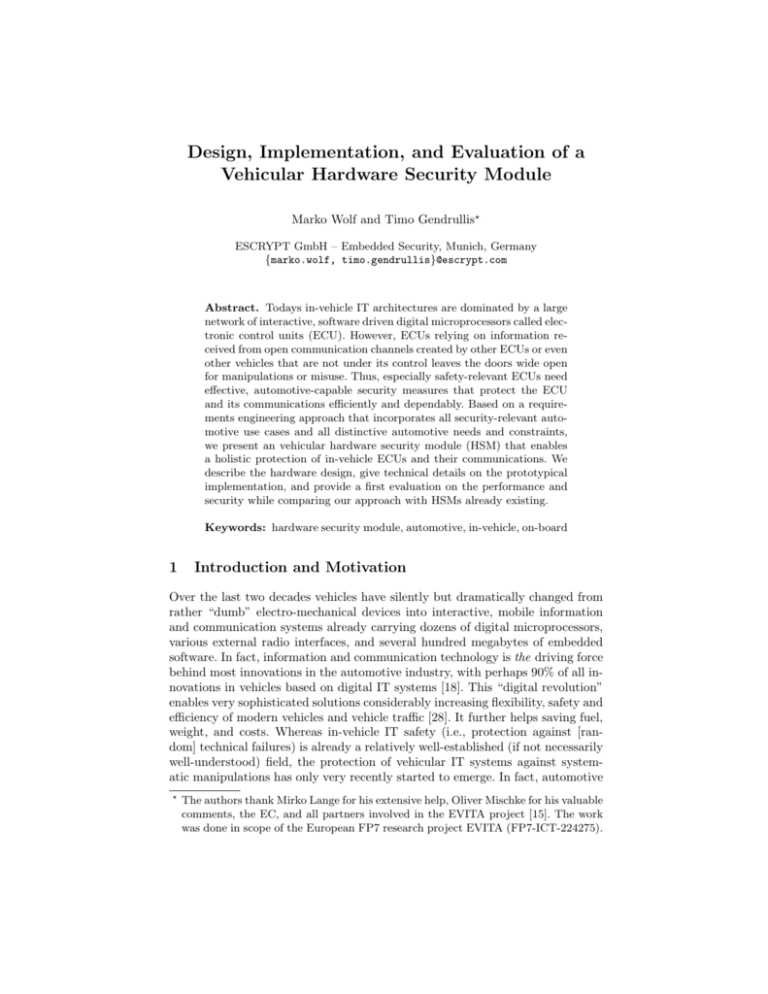
Design, Implementation, and Evaluation of a
Vehicular Hardware Security Module
Marko Wolf and Timo Gendrullis?
ESCRYPT GmbH – Embedded Security, Munich, Germany
{marko.wolf, timo.gendrullis}@escrypt.com
Abstract. Todays in-vehicle IT architectures are dominated by a large
network of interactive, software driven digital microprocessors called electronic control units (ECU). However, ECUs relying on information received from open communication channels created by other ECUs or even
other vehicles that are not under its control leaves the doors wide open
for manipulations or misuse. Thus, especially safety-relevant ECUs need
effective, automotive-capable security measures that protect the ECU
and its communications efficiently and dependably. Based on a requirements engineering approach that incorporates all security-relevant automotive use cases and all distinctive automotive needs and constraints,
we present an vehicular hardware security module (HSM) that enables
a holistic protection of in-vehicle ECUs and their communications. We
describe the hardware design, give technical details on the prototypical
implementation, and provide a first evaluation on the performance and
security while comparing our approach with HSMs already existing.
Keywords: hardware security module, automotive, in-vehicle, on-board
1
Introduction and Motivation
Over the last two decades vehicles have silently but dramatically changed from
rather “dumb” electro-mechanical devices into interactive, mobile information
and communication systems already carrying dozens of digital microprocessors,
various external radio interfaces, and several hundred megabytes of embedded
software. In fact, information and communication technology is the driving force
behind most innovations in the automotive industry, with perhaps 90% of all innovations in vehicles based on digital IT systems [18]. This “digital revolution”
enables very sophisticated solutions considerably increasing flexibility, safety and
efficiency of modern vehicles and vehicle traffic [28]. It further helps saving fuel,
weight, and costs. Whereas in-vehicle IT safety (i.e., protection against [random] technical failures) is already a relatively well-established (if not necessarily
well-understood) field, the protection of vehicular IT systems against systematic manipulations has only very recently started to emerge. In fact, automotive
?
The authors thank Mirko Lange for his extensive help, Oliver Mischke for his valuable
comments, the EC, and all partners involved in the EVITA project [15]. The work
was done in scope of the European FP7 research project EVITA (FP7-ICT-224275).
IT systems were never designed with security in mind. But with the increasing
application of digital software and various radio interfaces to the outside world
(including the Internet), modern vehicles are becoming even more vulnerable to
all kinds of malicious encroachments like hackers or malware [2]. This is especially
noteworthy, since in contrast to most other IT systems, a successful malicious
encroachment on a vehicle will not only endanger critical services or business
models, but can also endanger human lives [26]. Thus strong security measures
should be mandatory when developing vehicular IT systems. Today most vehicle
manufacturer (hopefully) incorporate security as a design requirement. However,
realizing dependable IT security solutions in a vehicular environment considerably differs from realizing IT security for typical desktop or server environments.
In a typical vehicular attack scenario an attacker, for instance, has extended attack possibilities (i.e., insider attacks, offline attacks, physical attacks) and could
have many different attack incentives and attack points (e.g., tachometer manipulations by the vehicle owner vs. theft of the vehicle components vs. industrial
espionage). Thus, just porting “standard” security solutions to the, moreover,
very heterogeneous IT environment usually will not work. However, there already exist some first automotive-capable (software) security solutions [29, 32].
But, especially with regard to potential internal and physical attackers, these
software solutions have to be protected against manipulations as well. In order
to reliably enforce the security of software security mechanisms, the application
of hardware security modules (HSM) is one effective countermeasure as HSMs:
– protect software security measures by acting as trusted security anchor,
– securely generate, store, and process security-critical material shielded from
any potentially malicious software,
– restrict the possibilities of hardware tampering attacks by applying effective
tamper-protection measures,
– accelerate security measures by applying specialized cryptographic hardware,
– reduce security costs on high volumes by applying highly optimized special
circuitry instead of costly general purpose hardware.
Unfortunately, there are currently no automotive-capable HSMs available (cf.
Section 2.2). Thus, the objective of this research was to design and prototype a
standardized automotive-capable HSM for automotive on-board networks where
security-relevant components are protected against tampering and sensitive data
are protected against compromise. The HSM was especially designed for protecting e-safety applications such as emergency break based on communications
between vehicles (V2V) or emergency call based on communications between
vehicles and (traffic) infrastructures (V2I).
Our Contributions and Paper Outline. After this motivation, Section 2
gives a short introduction into our design rationale for a vehicular HSM including a short state-of-the-art review of the related work. Section 3 then presents
the main objectives of this article, the design of a vehicular HSM concretely its
system architecture, communication interface, security building blocks and security functionalities. Section 4 gives a detailed, technical overview of the HSM
prototype implementation followed by a performance and security evaluation in
Section 5 that compares our HSM approach with other HSMs currently available.
2
The Need For Efficient Hardware Security
In this section we provide an introduction into our design rationale for realizing a
vehicular HSM. However, as this article focuses on the design, implementation,
and evaluation of a vehicular HSM, this section mainly summarizes the work
done before in [15] where the authors were involved, too. There, with a requirements engineering approach we identified all automotive use cases with a security
impact [6], that means, all use cases involving a security-critical asset or allow
for potential misuses. The security impacts identified are then transformed into
high-level security objectives that could thwart these impacts accordingly. For
fulfilling these security objectives, we then derived concrete (technical) security
requirements [7] including all related functional (security) requirements using an
appropriate security and trust model and reasonable “attack scenarios” [8].
2.1
Security and Functional Requirements Engineering
The security and functional requirements engineering is described in more detail
in [6, 7, 9]. It has yielded to the following HSM security requisites (SR) and
functional requisites (FR) as outlined below.
SR.1
SR.2
SR.3
SR.4
SR.5
SR.6
SR.7
Autonomous, strongly isolated security processing environment
Minimal immutable trusted code to be executed prior to ECU processor
Internal non-volatile memory for storing root security artifacts
Non-detachable (tamper-protected) connection with ECU hardware
Authentic, confidential, fresh comm. channel between HSM and ECU
Autonomously controlled alert functionality (e.g., log entry, ECU halt)
Only standardized, established security algorithms (e.g., NIST1 , BSI2 )
FR.1
FR.2
FR.3
FR.4
FR.5
Physical stress resistance to endure an automotive life-cycle of ≥20 years
Bandwidth and latency performance that meets at least ISO 11898 [24]
Compatibility with existing ECU security modules, i.e. with HIS-SHE [21]
Compatibility with existing ECU microprocessor architectures
Open, patent free specifications for cost-efficient OEM-wide application
2.2
Related Work
The vehicular HSM presented here is not the first security processor applied in
the automotive domain. Hence, there already exist some proprietary and singlepurpose HSM realizations used, for instance, by vehicle immobilizers, digital
tachographs [19] or tolling solutions [34]. However, these are no general-purpose,
1
2
US National Institute of Standards and Technology (www.nist.gov)
German Federal Office for Information Security (www.bsi.bund.de)
private HSMs and hence cannot be reused by other vehicular security solutions.
On the other hand, general-purpose HSMs that are currently available, for instance, the IBM 4758 cryptographic co-processor [4], the TCG Mobile/Trusted
Platform Module [35], or typical cryptographic smartcards are not applicable
for use within an automotive security context. They, for instance, lack of cost
efficiency, performance, physical robustness, or security functionality. Solely, the
secure hardware extension (SHE) as proposed by the HIS consortium [21] takes
an exceptional position as it was explicitly designed for application in a automotive security context. However, the SHE module is mainly built for securing
cryptographic key material against software attacks, but cannot be used, for instance, to protect V2X communications. An overview comparison of the HSM
proposed in this work with the general-purpose HSMs is given later in Table 5.
3
Design
This section describes the hardware architecture and security functionality of
our HSM. The corresponding full detailed HSM specification can be found in [9].
3.1
System Architecture
As shown in Figure 1, the hardware architecture design is based on a closed
on-chip realization with a standard ECU application core and the HSM together
on the same chip connected by an internal communication link. Hence, HSM
commands are not explicitly and individually protected at hardware level. That
means they are communicated in plain and without any replay and authenticity
protection between HSM and application core. However, a TCG like command
protection approach based on session keys and rotating nonces [35] is possible.
The interface to the internal communication bus and external communication peripherals (if existing) are managed by the application core. The HSM consists of
an internal processor (secure processor ), some internal volatile and non-volatile
memories (secure memory), a set of hardware security building blocks, hardware
security functionality, and the interface to the application core. In order to en-
Fig. 1. Overall vehicular hardware security module architecture (full module)
able a holistic but cost-efficient in-vehicle security architecture, there exist at
least three different HSM variants – full, medium, and light – each focusing on
different security use cases with different cost, functional and security requirements. However, these variants are no isolated developments, in fact, the light
and medium module are proper subsets of the full module. The full module
focuses on securing V2X communications and securely connecting the external
vehicle interface(s) with the in-vehicle IT infrastructure. Due to its central importance and due to the strong V2X requirements, the full HSM provides the
maximum level of functionality, security, and performance applying amongst
others a very powerful hardware-accelerated asymmetric cryptographic building
block, as shown in Figure 1. The medium module focuses on securing the invehicle communication. Hence the medium module has no dedicated hardwareaccelerated asymmetric cryptographic building block, no dedicated hardwareaccelerated hashing function, and a somewhat less performing internal processor.
Even though, the medium HSM has no asymmetric cryptography in hardware,
it is nonetheless able to perform some non-time-critical asymmetric cryptography operations (e.g., key exchange protocols) using the internal processor and
firmware. As for efficiency and cost reasons virtually all internal communication
protection is based on symmetric cryptographic algorithms, omitting the asymmetric cryptography and hashing hardware blocks is reasonable to save costs,
size and power consumption. The light module focuses on securing the interaction of ECUs with sensors and actuators and is able to fulfill the strict cost and
efficiency requirements typical there. In comparison with the medium module,
the light module is again minimized and contains only a hardware-accelerated
symmetric cryptography engine, a hardware random number generator, a UTC
clock together with some very small optional volatile and non-volatile memories.
3.2
Hardware Interface in General
The HSM applies an asynchronous (i.e., non-blocking) hardware interface. The
interface is multi-session capable (i.e., interruptible) for all security building
blocks (cf. Section 3.3) that use a session identifier (e.g., encryptions, signatures,
hash functions). Single session (i.e., non-interruptible) security building blocks,
in contrast, are the random number generator, all counter functionality and all
higher-level security functionality (cf. Section 3.4). Internally, the HSM is singlethreaded in general, but provides limited multi-threading if different hardware
functionality is accessed in parallel. Thus, for instance, one can invoke a hardware
encryption in parallel with a random number generation, but not two encryptions
with the same hardware encryption building block at the same time. Finally, as
the HSM functionality is a proper superset of the HIS SHE functionality [21]
and should be able to process all SHE commands.
3.3
Hardware Security Building Blocks
This section describes the (always) hardware-protected and (selected) hardwareaccelerated security building blocks (SBB) available.
Asymmetric crypto engine enables creation and verification of digital signatures with the asymmetric signature algorithm specified on invocation using different hashing functions, different padding schemes and optional timestamping. The full and medium prototype modules provide an ECC-256 (i.e.,
NIST P-256 [16] based) signature function that is hardware-accelerated at the
full module. Full and medium prototype modules also provide the elliptic curve
integrated asymmetric encryption scheme (ECIES) [1].
Symmetric crypto engine enables symmetric encryption and decryption with
the cipher specified on invocation including different modes of operation (e.g.,
ECB, CBC, GCM) and different padding schemes (e.g., bit padding, PKCSx) – if
available. As shown in Figure 1, all prototype modules provide at least the AES128 block cipher [17].The symmetric crypto engine further enables generation
and verification of message authentication codes (MACs) that optionally can
get time-stamped using the internal tick or UTC clock (if synchronized). Thus,
all prototype modules provide at least AES-128 CMAC [33] functionality.
Cryptographic hash function enables generation and verification of plain
hash fingerprints and additionally HMACs (hash-based message authentication
code) calculated with a secret key with the hashing algorithm specified on invocation. This SBB also provides optional time-stamping of the hashes/HMACs
generated using the internal UTC clock (if synchronized). The full and medium
prototype modules provide an ISO 10118 Whirlpool [23] hashing function that
is hardware-accelerated at the full module.
Pseudo random number generator (PRNG) creates pseudo random numbers with a PRNG algorithm specified on invocation that can be seeded internally from a physical true random number generator (TRNG) or from an
external TRNG during production in a controlled environment of the chip manufacturer. The latter case additionally requires a proper seed update protocol.
All prototype modules provide at least an officially evaluated PRNG according
to E.4 [31] (e.g., AES- or hash-based).
Internal clock serves as hardware-protected time reference that can be synchronized with UTC time. For further details see Section 3.4.
Monotonic counters servs as a simple secure clock alternative while providing
at least 16 monotonically increasing 64-bit counters together with corresponding
access control similar to TCG’s monotonic counters [35].
A distinctive feature of the HSM is the possibility for very fine-grained application specific authorizations for the processing and the migration of internal
security assets. Concretely, a key can have several individual authorizations that
allow or forbid processing it in different SBBs specified by so-called use flags.
As shown in the example in Table 1, a symmetric key, for instance, can have
a use flag for using it for MAC verifications but has a different use flag (or
even no use flag) for using it for the creation of MACs. Our HSM prototype
supports key use flags each with individual authorizations for processing and
migration at least for signing, signature/MAC verification, data encryption and
decryption, time stamping, secure boot, secure storage, clock synchronization,
key creations and key transports. Moreover, these use flags can have individual migration authorizations that specify their transport restrictions to locations
outside the respective HSM (cf. Section 3.4). Thus, a use flag can be restricted
to be moved (i) to no other location (internal ), (ii) only between HSMs identical
in construction (migratable), (iii) only between HSMs and trusted OEM locations
(oem), or freely to any other location (external ). For example, the use flag verify for signature verification of a certain key can be allowed to become migrated
to another HSM (migratable), while the use flag sign for signature creation of
the same key cannot be moved to a location outside its local HSM (internal ).
Lastly, each use flags can have also its individual authorizations required for
each invocation that can be simple passwords, can be based on the individual
ECU platform configuration as measured at ECU bootstrap (cf. Section 3.4), or
could be even a combination of both (i.e., configuration and password).
Table 1. Internal key structure including # of instances per field
key identifier [1]
algorithm identifier [1..n]
expiration date [1]
key signatures [0..n]
public key data [0..1]
private key data [0..1]
use flag [1..i..n] transport flag [i] auth. flag [i] auth. value [0..i]
sign
verify
3.4
internal
migratable
password
ecr
Hash(“abc”)
ECR(0;1;7) = 0x123
Hardware Security Logic and Functionality
This section gives a short description of some central HSM keys and the underlying key hierarchy used by our HSMs. The manufacturer verification key (MVK)
is a key from the module manufacturer to verify the authenticity of other HSMs
or to authenticate HSM firmware updates. The device identity key (IDK) enables
global HSM identification and authentication. The IDK is unique per module,
fixed for HSM lifetime, and signed by MVK. The OEM verification key (OVK)
is a key from an OEM to have an additional OEM managed trust domain similar
to the manufacturer trust domain controlled via MVK. The OVK is unique per
OEM and is also fixed for HSM lifetime. The clock synchronization key(s) (CSK)
are a verification keys from a trusted time reference (e.g., a certain GPS module
trusted by the HSM manufacturer) accepted for synchronizing the internal tick
counter to absolute UTC time. The CSK is signed by MVK. The storage root
key (SRK) is the (symmetric) master parent key for securely swapping internally created keys to external storages similar to the SRK as introduced by the
TCG [35]. The stakeholder key(s) (SxK) finally are all externally created symmetric (SSK) or asymmetric (SAK) keys for stakeholder individual usage such
as authentication, secure feature activation, or content protection. To increase
(external) trust into SxK and OVK, they can be signed by MVK as well.
Key management provides functionalities for internal key creation (using the
internal RNG), key import and export. The HSM further provides hardwareprotected functionality for Diffie-Hellman key agreements [3] and for symmetric
key derivations, for instance, according to ISO 18033 [25]. The creator of a
key has the possibility to set individual usage authorizations (use flags) and
transport authorizations (trnsp flags) for each key usage as introduced in Section 3.3 and Table 1. Note that some key flags cannot always be set freely but
are inherently set by the HSM (e.g., the internal transport flag). For moving
keys between different HSMs, between HSMs and external (trusted) locations (if
permitted), the HSM provides key import and export functionality that ensures
confidentiality of private key internals via (symmetric or asymmetric) transport
encryption as well as authenticity of all key data structures via (symmetric or
asymmetric) so-called transport authenticity codes (i.e., a digital signature or a
MAC). Strictly speaking, not the whole key itself is moved, but only individual
key use flags if they have proper transport authorizations (trnsp flags). The
trnsp flags inherently define also the keys that can be used for transport encryption and authenticity enforcement. Hence, use flags of keys marked internal
are only permitted to become swapped out to offline storage and imported again
to the same HSM via the SRK. Use flags of keys marked migratable are additionally permitted to become moved between HSMs identical in construction. This is
enforced by accepting only target IDKs for transport encryption that are signed
by a trusted MVK (e.g., MVKs from the same manufacturer used for HSMs of
at least equal physical security). A similar approach is foreseen for use flags of
keys marked oem that accept for transport encryption only keys that are signed
by a trusted OVK. This was introduced to support an OEM managed trusted
domain that can be differentiated (but not enforced!) by the HSM in contrast
to use flags of keys marked external that are fully out of the control of the HSM
for enforcing any trust assumptions.
Secure boot and authenticated boot is realized using HSM-internal socalled ECU configuration registers (ECR) that are similar to TCG’s platform
configuration registers (PCR) [35]. In contrast to the TCG approach, our HSM
is also acting as the – by all involved parties a priori trusted3 – core root of trust
(CRT) that initializes the chain of trust for ECU integrity and authenticity verification. Assuming a multi-stage bootstrap with the CRT executed first, the
trust chain is built by a hierarchical step by step measuring of the program code
of all upper layers i such as the boot ROM, the boot routine, the boot loader,
and all consecutive layers that are part of the Trusted Computing Base(TCB)4 .
For the HSM, the corresponding measurement routine m() that creates a small
unique fingerprint fi for each program code measured, is the Whirlpool oneway hash function for full and medium modules and the AES-MAC for light
modules5 . The fingerprint fi in turn is saved to an individual ECRn protected
against manipulations inside the HSM before the next stage becomes executed.
3
4
5
It is per definition impossible to self-verify the integrity of the core root of trust.
The TCB means all code of the ECU that can be critical for ECU security.
The bootstrap security functionality is optional for light HSMs.
In order to prevent the overwriting of a previously saved ECR by layers executed
later, ECRs in fact can only become extended via ECRn [t] = m(ECRn [t-1], fi )
that connects the new fingerprint fi cryptographically with the old ECRn [t-1]
value and hence prevents overwriting. To detect and counteract possible validation failures, there exist at least two different approaches, usually known as
secure boot and authenticated boot. In case the HSM can be deployed as active
module (e.g., as ECU master) and hence having autonomous control to the corresponding ECU or an alarm function, the HSM can realize the active secure
boot approach. Then the procedure executed at each step of the bootstrap uses
the HSM to compare the actual value of an ECRn [t] with the corresponding
reference value ECRn,ref that can securely preset for each ECR (cf. [9] for further details). In case of a mismatch between ECRn [t] and ECRn,ref , secure boot
automatically yields to an immediate response (e.g., ECU halt or alarm). Authenticated boot, in contrast, remains rather passive while only measuring the
bootstrap without any direct interventions. It can be used if the HSM can be deployed as passive add-on module only having no autonomous control to the ECU
or no alarm function. By using the authenticated boot approach, some essential
key use flags) (e.g., decryption) can become inaccessible afterwards in case
the actual bootstrap measurements do not match the ECR reference individually linked for this particular use flag) by the key owner. Our HSM therefore
can enforce individual ECR references ECRn,ref as additional use flag invocation authorization (cf. Section 3.3) that makes the corresponding key use flag
inaccessible (and only this) in case of an ECR mismatch.
Secure clock is realized by a so-called tick counter tc that is monotonically
increasing during HSM runtime using a fixed tick() interval of at least 1 Hz.
As shown in Table 2, the initial value of tc on HSM’s first initialization in life is
tc = 0 or tc = UTC(t0 ) that represents a UNIX/POSIX encoded default time
value, for instance, the HSM release date. After any reset, the HSM continues
increasing tc unsynchronized (i.e., tc < UTC(t)), but starting with the last internally saved6 value of tc . This provides a simple relative secure clock that – even
if seldom or never synchronized – never “runs slow”. However, optionally tc can
be synchronized to absolute UTC time received from an external UTC source
(e.g., in-vehicle GPS sensor) trusted by the HSM manufacturer (e.g., in-vehicle
GPS sensor). Therefore, the HSM can be invoked with the actual UTC time and
the HSM synchronization challenge (as requested from the HSM before) both
signed with a trusted CSK (cf. Section 3.4).
Administration and audit functionality provides HSM status information,
self tests, internal state backup, migration, and updates. Auditing the HSM
operations can enhance the security by enabling an (external) auditor to retrace
for instance critical operations (e.g., key migrations) or critical incidents that
have occurred (e.g., authorization failures, resource exhaustions).
6
The internal saving interval for tc depends on the rewrite capabilities of the HSM
internal non-volatile memory and can vary from seconds up to hours or even days,
but is always inherently invoked after a successful UTC synchronization.
Table 2. HSM clock with relative tick time optionally synchronized to absolute UTC
On clock event
First initialization in HSM life
Internal tick() after reset
External UTC synchronization
Internal tick() after sync
3.5
tc
0 or UTC(t0 )
tc ++
UTC(t)
tc ++
tc
tc
tc
tc
tc
vs. UTC(t)
< UTC(t)
< UTC(t)
= UTC(t)
= UTC(t)
Driver Software and Software Security Framework
The HSM provides a set of basic hardware security functionalities on which a
larger set of more sophisticated software security mechanisms can be built on.
However, these higher-level software security mechanisms are not part of this
work. But the corresponding HSM low-level software driver [12], an appropriate high-level software security framework [13] and proposals for implementing
secure on-board protocols using the HSM as basis [10] are already available.
4
Implementation
The HSM architecture has been prototypically implemented [11] on a Xilinx
Virtex-5 FPGA (XC5VFX70T-1FF1136C ). This FPGA has a total amount of
11,200 slices (i.e., 44,800 both flip-flops (FF) and 6-input look-up tables (LUT)),
128 dedicated digital signal processing (DSP) blocks, and 148 Block-RAMs
(BRAMs) with 36 Kb of memory each. Additionally, the FPGA comprises an embedded hard-coded microprocessor block, that is, a PowerPC 440 (PPC440) with
a maximum frequency of 550MHz. The FPGA comes on the Virtex-5 FXT FPGA
ML507 Evaluation Platform with all necessary peripherals such as various interfaces, both volatile memory and non-volatile memory (NVM), and power supply. The application processor was implemented on an Infineon TriCore TC1797
with all necessary peripherals and resources (i.e., application NVM, application RAM, communication interfaces) available on a corresponding development
board. Both development boards are mechanically and electrically attached to
each other via a custom-made connection board that provides access from the
application core to the HSM. For this purpose the connection board wires the
TC1797’s external SPI bus with general purpose in-/output pins (GPIOs) of the
FPGA. Figure 2 gives an overview of the layered approach of the HSM implementation. In the prototypical design, the HSM’s secure processor is mapped
to the embedded PPC440 of the FPGA that runs at 400 MHz with a standard
Linux 2.6.34 kernel as operating system. This is the basis to host software implementations of the HSM firmware, the cryptographic library, and the Linux
kernel drivers to access the hardware cores. The hardware cores implemented in
the configurable logic of the FPGA are connected to the PPC440 via the 32 bit
wide Xilinx specific processor local bus (PLB). Thus, the interface between software and hardware implementation has a theoretical throughput of 3 Gbit/s at
the given PLB bus speed of 100 MHz.
Fig. 2. Architectural overview of the prototypical HSM implementation
First, all SBBs of Section 3.3 (also cf. Figure 1) and all HSM security functionalities of Section 3.4 were implemented in software (i.e., HSM library) as
a reference for verification and performance analysis. The underlying cryptographic primitives of the SBBs were made available in a cryptographic software
library (i.e., CycurLIB [5]). Afterwards, those cryptographic primitives involved
in the vast majority of all SBBs were additionally implemented in hardware (i.e.,
AES-128, ECC-256, and Whirlpool). In a straight-forward approach, they were
wrapped with the PLB interface and cryptographic algorithms in software were
enhanced by non-blocking hardware calls via custom SBB Linux kernel drivers.
Different modes and protocols based on one of the three cryptographic primitives in hardware are also part of the cryptographic library using the hardware
calls. SBBs complementary to these three algorithms remain available as pure
software. The HSM firmware is the top level entity that handles all communication requests, that means, all requests from internal hardware cores and
also all external requests (i.e., from the application processor). Access from the
application processor to the secure processor of the HSM is provided via the
configuration, control and status module (CCS). The CCS is also part of the
HSM and its basic task is to make the communication interface independent
(i.e., to abstract it) from the underlying physical communication medium. The
CCS includes a shared message RAM to buffer issued commands and their answers. The instantiation of the CCS module in the HSM prototype utilizes an
SPI slave module with a data rate of 22.5 Mbit/s to connect the HSM to the
TC1797. However, because of the separate CCS abstraction layer, the design can
be easily enhanced to physical communication mediums other than SPI (e.g., to
a socket based communication using TCP/IP over Ethernet for demonstration
purposes with standard PCs). Since a serial bus (i.e., SPI) connects the HSM
with the application processor all data has to be serialized before transmitting
and de-serialized after receiving. This is done by a separate (de-)serialization
layer using abstract syntax notation number one (ASN.1 [22]). At the application processor side, commands are serialized accordingly into a binary encoding
and return values are deserialized with the common ASN.1 representation of
the HSM API. The SBBs implemented in hardware are briefly described in the
following. Afterwards, Table 3 shows a comparison of the entire HSM system design and the single SBB hardware implementation results (time and area) after
synthesis. The synthesis results for the SBBs are mentioned as well for the sole
hardware core as for the core with hardware overhead for PLB integration.
AES-128 was implemented in ECB mode with a focus on a very low area,
still providing a reasonable performance. To keep the design small, the implementation is comprised of four 8 bit S-boxes that are shared between all round
functions and the key scheduling. With this architecture, encrypting one 128 bit
block in ECB mode takes 53 clock-cycles. As the AES operates with a clock of
100 MHz, it has a theoretical throughput of 242 Mbit/s. For decryption, the AES
needs another 53 clock-cycles to perform the key scheduling each time a new decryption key is used. Thus, in the worst case, the decryption data rate decreases
to 50% compared to encryption. Due to the small hardware footprint, several
instances could be mapped to the design in parallel to increase the performance.
Since all remaining operation modes of AES (e.g., CBC) share the ECB mode
as their common atomic operation, they are realized in software finally using
hardware calls of the AES core in ECB mode.
WHIRLPOOL was implemented with a moderate time-area trade off. Both,
the underlying 512 bit block cipher W (which is very similar to AES) and the enclosing Miyaguchi-Preneel compression function were implemented in hardware.
In our implementation, the 512 bit state of W consists of eight 8 Byte blocks
operating on eight 8 bit S-boxes. Both the round function and the key scheduling share all computational modules (i.e., S-boxes, ShiftColumns, MixRows).
With this architecture, one 512 bit block operation takes 308 clock-cycles. To
keep the number of different clock domains in the HSM design at a minimum,
Whirlpool operates at the same clock of 100 MHz as the AES-128 resulting in
a theoretical throughput of 166 Mbit/s.
ECC-256 was implemented based on the work of Güneysu and Paar [20] with
a strong emphasis on performance optimization. Only the point multiplication
of the NIST P-256 [16] ECC operation is implemented in hardware while all remaining parts of the algorithm are still performed in software. Even though this
is only a small portion of the algorithm it covers over 90% of the entire ECC
computation time. The design is highly optimized for the Xilinx DSP architecture and uses a pipelined architecture with input and output queues. Operated
at a clock of 200 MHz, one ECC point multiplication (for signature generation)
with 303,450 clocks takes 1.52 ms on average (i.e., 659 OP/s) and two point multiplications plus one addition with 366,905 clocks takes 1.83 ms (i.e., 545 OP/s).
5
Evaluation
This section provides an evaluation on HSM performance and HSM security
based on the security requirements stated in Section 2 together with a comparison of our HSM approach with other relevant HSMs already existing.
Table 3. Synthesis results for the prototypical HSM implementation
Module
AES standalone
AES with PLB
Whirlpool standalone
Whirlpool with PLB
ECC standalone
ECC with PLB
HSM system
5.1
FF
279
744
2,656
3,445
1,854
2,102
16,273
LUT BRAM DSP Critical Path
1,137
0
0
9.878 ns
1,399
0
0
9.860 ns
2,932
0
0
6.364 ns
3,826
0
0
6.386 ns
1,964
13 32
3.539 ns
2,095
13 32
4.426 ns
18,664
37 45
—
Performance Analysis
After fully implementing and extensively testing the HSM hardware design, the
implementation was finally deployed on the target platform. Table 4 shows a
comparison of the hardware cores’ theoretical throughput from the previous section and the SBB performances measured in both pure software and hardware
accelerated versions. All measurements were performed on the internal PPC440
based on the cryptographic library CycurLIB [5] enhanced by drivers for hardware core access. On first sight, the AES-128 hardware accelerated implementation gains only between 5 − 40% compared to the pure software solution.
Moreover, it reaches only 20 − 41% of the theoretical throughput of the hardware core depending on the mode of operation. This seemingly small yield of
performance is mainly caused by the very high bidirectional data traffic over
the PLB bus. Since the AES core operates only on single 128 bit blocks in ECB
mode, each en-/decryption requires first sending and afterwards receiving a small
block of 128 bit data. Additionally, all remaining modes (including MAC generation) have to perform their protocol overhead in software based on the ECB
block operation in hardware. Together with (bus) latencies this explains the relatively small performance gain. With DMA (direct memory access) usage and
slight modifications to the hardware implementation, e.g., enhancing wrappers
for different operation modes, buffers for in-/output data or using pipelining,
the throughput could be increased vastly. On the other hand, the Whirlpool
implementation reaches 77% of its theoretical performance in hardware. Similar
to the AES, it operates on single blocks (of 512 bit for Whirlpool) but the
communication remains unidirectional except for the last block of the hash computation when the result is returned. This saves a vast amount of bus traffic (and
latencies). While the hardware performance benefits from the larger block size of
W (i.e., 512 bit), it makes computation in software much harder. Actually, the
hardware accelerated Whirlpool outperforms the software version by a factor
of 25. Optimizing the software implementation might reduce this gap slightly but
will never close it entirely. From all SBBs, ECC-256 benefits the most from the
hardware acceleration. The more complex ECDSA signature verification (two
ECC point multiplications plus one addition vs. one ECC point multiplication
only) is 29 times faster in hardware than in software. Since one ECC operation
requires only sending 1024 bit and receiving 512 bit data, the requirements on
communication bandwidth are very low. This allows the ECC core to reach up
to 80% of its theoretical throughput although the complete ECDSA protocol
(except for the point multiplication) is performed in software.
Table 4. Comparison of SBB Performance-Measurements in Software and Hardware
Throughput
SBB Mode
SW (measured) HW (measured) HW (theoretical)
AES-128, ECB encrypt
53 Mbit/s
76 Mbit/s
242 Mbit/s
AES-128, ECB decrypt
53 Mbit/s
58 Mbit/s
121 Mbit/s
AES-128, CBC encrypt
46 Mbit/s
68 Mbit/s
242 Mbit/s
AES-128, CBC decrypt
44 Mbit/s
46 Mbit/s
242 Mbit/s
AES-128, CMAC generate
44 Mbit/s
60 Mbit/s
242 Mbit/s
Whirlpool, hash generate
5 Mbit/s
128 Mbit/s
166 Mbit/s
ECC-256, ECDSA generate
30 sig/s
480 sig/s
659 OP/s
ECC-256, ECDSA verify
15 sig/s
436 sig/s
545 OP/s
5.2
Security Analysis
This section shortly analyses the fulfillment of the security requirements (SR)
stated in Section 2 by our HSM approach. We fulfill SR.1 (isolated security
processing environment) as our HSM is realized as an autonomous microprocessor with its own independent memories (physically) isolated from the ECU
main processor (cf. Section 3.1). The shielded execution environment can also
be strengthened further against physical manipulations by applying appropriate physical tamper-protection measures [27]. We fulfill SR.2 (immutable core
root of trust code) by having foreseen an HSM deployment architecture that either assumes an active HSM (part) executed prior to the ECU main processor
or an additional, small, immutable component that initializes the hierarchical
bootstrap measurements (cf. Section 3.1). We fulfill SR.3 (internal non-volatile
memory) by having our HSM foreseen at least about 64kB non-volatile memory for shielded storing of security root artifacts (cf. Section 3.1 and Figure 1).
We fulfill SR.4 (non-detachable connection with ECU hardware) by assuming a
system-on-chip (SoC) design, for instance, that ensures at least tamper evidence
if someone tries to detach the HSM from the corresponding ECU. However,
in the end, this requirement has to be fulfilled by the ASIC system designer,
who can apply different powerful tamper protection measures (e.g., cf. [27]). We
fulfill SR.5 (secure HSM-ECU communication channel ) by assuming a secure
communication channel between HSM and ECU realized by appropriate physical tamper protection, for example, by assuming an SoC communication line. In
case this is not possible, we propose to realize a secure communication channel
by cryptographic means, for instance, as proposed by TCG’s command transport encryption [35]. However, the additional cryptographic protection of HSM
commands is not part of our current design. We fulfill SR.6 (autonomously controlled alert functionality) by moving this alert functionality inside the HSM’s
cryptographic boundary (cf. Figure 1). The specification of the actual alert response (e.g., from autonomous log entry up to ECU full stop), however, should
be defined by the respective ECU application (engineer). We finally also fulfill
SR.7 (standardized, well-established security algorithms) for all security building
blocks, concretely by applying the NIST advance encryption standard [17] for
symmetric encryption, the NIST digital signature standard [16] for asymmetric
encryption, the ISO hash function standard [23] for cryptographic hashing, a
BSI evaluated PRNG according to E.4 [31] for random number generation, and
the ISO standardized ECDH [25] for key agreements.
5.3
Comparison with Other Hardware Security Modules
This section provides an overview comparison of our HSM with other hardware
security modules currently available. Table 5 compares our three different HSM
variants – full, medium, and light – with the Secure Hardware Extension (SHE)
as proposed by HIS [21], with the Trusted Platform Module (TPM) as proposed
by the TCG [35], and with a typical cryptographic smartcard (SmC). While
the TPM and the smartcard were neither designed nor applicable for use within
an automotive security context (as they lack, for instance, in cost efficiency,
performance, physical robustness, or security functionality), SHE was explicitly
designed for application in an automotive security context. It can be seen that
the HSM is quite successful in merging the relevant security functionalities from
SHE, from the TPM and from a typical smartcard while transferring them into
the automotive domain with its strict cost efficiency and performance requirements. Beyond this, Table 5 clearly indicates the distinctive security features, for
instance, the possibility for very fine-grained application-specific authorizations
for the processing and the migration of internal security assets or the possibility
for a secure (UTC) time reference, that are exclusively available with this HSM.
6
Conclusion and Outlook
Based on a tight automotive-driven security requirements engineering, we have
designed, implemented, and evaluated a vehicular hardware security module that
enables a holistic protection of all relevant in-vehicle ECUs and their communications. Practical feasibility will be proven with first HSM-equipped passenger
vehicle demonstrators [14] by end of 2011. Further large-scale field operational
tests with hundreds of HSMs and HSM-equipped vehicles that amongst others
address performance, scalability, and deployment of our HSM approach are already scheduled in a subsequent research project [30]. We are convinced that
future interactive vehicles can be realized in dependable manner only based on
an effective, efficient holistic in-vehicle security architecture, which in turn is
based upon effective and efficient vehicular HSM as presented by this work.
Table 5. Comparison with other hardware security modules
Cryptographic algorithms
ECC/RSA
AES/DES
WHIRLPOOL/SHA
Hardware acceleration
ECC/RSA
AES/DES
WHIRLPOOL/SHA
Security features
Secure/authenticated boot
Key AC per use/bootstrap
PRNG with TRNG seed
Monotonic counters 32/64 bit
Tick/UTC-synced clock
Internal processing
Programmable/preset CPU
Internal V/NV (key) memory
Asynchronous/parallel IF
Annotation: = available, =
Full
Medium Light
SHE
TPM
SmC
/
/
/
/
/
/
/
/
/
/
/
/
/
/
/
/
/
/
/
/
/
/
/
/
/
/
/
/
/
/
/
/
/
/
/
/
/
/
/
/
/
/
/
/
/
/
/
/
/
/
/
/
/
/
/
/
/
/
/
/
/
/
/
/
/
/
/
/
/
/
/
/
/
/
/
/
/
/
not available, = partly or optionally available
References
1. Abdalla, M., Bellare, M., Rogaway, P.: DHAES: An encryption scheme based on
the Diffie-Hellman problem. Submission to P1363a: Standard Specifications for
Public-Key Cryptography, Additional Techniques 5 (2000)
2. Checkoway, S. et al.: Comprehensive Experimental Analyses of Automotive Attack
Surfaces. National Academy of Sciences Committee on Electronic Vehicle Controls
and Unintended Acceleration (2011)
3. Diffie, W., Hellman, M.: New Directions in Cryptography. IEEE Transactions on
Information Theory 22(6) (1976)
4. Dyer, J., Lindemann, M., Perez, R., Sailer, R., Van Doorn, L., Smith, S., Weingart,
S.: Building the IBM 4758 Secure Coprocessor. IEEE Computer 34(10) (2001)
5. escrypt GmbH – Embedded Security: CycurLIB - Cryptographic Software Library.
www.escrypt.com/products/cycurlib/overview/ (2011)
6. EVITA: Deliverable 2.1: Specification and Evaluation of E-Security Relevant Use
Cases (2008)
7. EVITA: Deliverable 2.3: Security Requirements for Automotive On-Board Networks Based on Dark-Side Scenarios (2009)
8. EVITA: Deliverable 3.1.2: Security and Trust Model (2009)
9. EVITA: Deliverable 3.2: Secure On-board Architecture Specification (2010)
10. EVITA: Deliverable 3.3: Secure On-Board Protocols Specification (2010)
11. EVITA: Deliverable 4.1.3: Security Hardware FPGA Prototype (2011)
12. EVITA: Deliverable 4.2.2: Basic Software (2011)
13. EVITA: Deliverable 4.3.2: Implementation of Software Framework (2011)
14. EVITA: Deliverable 5.1.2: On-board Communication Demonstrator (2011)
15. EVITA Project: E-safety Vehicle Intrusion proTected Applications, European
Commission research grant FP7-ICT-224275. www.evita-project.org (2008)
16. FIPS-186-3: Digital Signature Standard (DSS). NIST (1994, 2006)
17. FIPS-197: Advanced Encryption Standard (AES). NIST (2001)
18. Frischkorn, H.G.: Automotive Software – The Silent Revolution. In: Workshop on
Future Generation Software Architectures in the Automotive Domain, San Diego,
CA, USA, January 10 – 12 (2004)
19. Furgel, I., Lemke, K.: A Review of the Digital Tachograph System. In: Embedded
Security in Cars: Securing Current and Future Automotive IT Applications. Springer (2006)
20. Güneysu, T., Paar, C.: Ultra High Performance ECC over NIST Primes on Commercial FPGAs. In: Proceedings of the 10th International workshop on Cryptographic Hardware and Embedded Systems (2008)
21. Herstellerinitiative Software (HIS): SHE Secure Hardware Extension Version 1.1.
http://portal.automotive-his.de (2009)
22. International Telecommunication Union – ITU-T Study Group 7: Abstract Syntax
Notation number One – ASN.1. www.itu.int/ITU-T/asn1/ (1995)
23. ISO/IEC 10118-3:2004: Information technology – Security techniques – Hashfunctions – Part 3: Dedicated hash-functions. ISO/IEC (2004)
24. ISO/IEC 11898:2003-2007: Information technology – Road vehicles Controller area
network. ISO/IEC (2007)
25. ISO/IEC 18033-2:2006: Information technology - Security techniques - Encryption
algorithms - Part 2: Asymmetric ciphers. ISO/IEC (2006)
26. Koscher, K. et al.: Experimental Security Analysis of a Modern Automobile. In:
IEEE Symposium on Security and Privacy (2010)
27. Lemke, K.: Physical Protection against Tampering Attacks. In: Embedded Security
in Cars: Securing Current and Future Automotive IT Applications. Springer (2006)
28. Luo, J., Hubaux, J.: A Survey of Inter-Vehicle Communication. EPFL, Lausanne,
Switzerland, Tech. Rep (2004)
29. PRECIOSA Project: Privacy Enabled Capability in Co-operative Systems and
Safety Applications. www.preciosa-project.org (2008)
30. PRESERVE Project: Preparing Secure Vehicle-to-X Communication Systems.
www.preserve-project.eu (2011)
31. Schindler, W.: AIS 20 – Functionality classes and evaluation methodology for deterministic random number generators. German Federal Office for Information Security (BSI) (1999)
32. SeVeCom Project: Secure Vehicular Communication. www.sevecom.org (2006)
33. Song, J., Poovendran, R., Lee, J., Iwata, T.: The AES-CMAC Algorithm.
RFC4493, IETF, June (2006)
34. Toll Collect GmbH: www.toll-collect.com (2011)
35. Trusted Computing Group (TCG): TPM Specification 1.2 Revision 116. www.
trustedcomputinggroup.org (2011)

